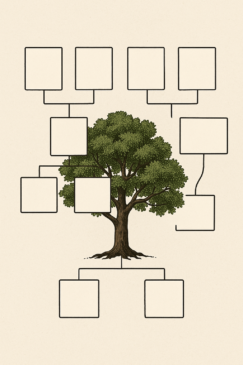I first saw it on her Facebook page: a bright, colorful graphic of our family tree. It had a big title at the top—“Our Family Through the Years”—and branches filled with names and photos. It was one of those beautifully designed charts you could print and frame.
At first, I smiled. Then my eyes scanned the branches. My name was there, my siblings’ names were there, but one person was missing entirely—my dad.
The Shock
My parents divorced when I was ten. It wasn’t a friendly split, but my dad had always been a part of my life. He attended my school plays, called me every week, and never missed a birthday. So seeing a family tree that erased him completely hit me like a punch to the chest.
I kept scrolling, hoping maybe she had just posted one version for her side of the family. But the caption read:
“Finally finished our family history! So proud to share it with everyone.”
It was clear she saw this as the definitive record.

Why It Hurt
This wasn’t just about a missing name—it was about the message it sent. It felt like she was rewriting history to remove him from my story. No matter how strained their relationship might be, he was still my father.
Leaving him out made it look like I came from one half of a family, when in reality, my life had always been made up of both.
The Conversation
I called her later that day. “Mom, I saw the family tree you posted. Why isn’t Dad on it?”
She sighed. “Because it’s about my side of the family. I didn’t think it was necessary to include him.”
“But he’s part of my family,” I said, trying to keep my voice calm. “When you leave him out, it feels like you’re erasing part of who I am.”
She hesitated. “I didn’t mean it that way. I just don’t want to see his name on something that’s hanging in my house.”
The Deeper Issue
Her choice wasn’t about a graphic—it was about unresolved feelings toward my dad. But her decision had collateral damage. In trying to remove him from her life, she’d unintentionally removed him from mine in a public, visual way.
Trying to Find Common Ground
I suggested she make two versions—one that represented her side only, and one that showed the complete picture for me and my siblings. At first, she resisted, saying it was “too much work.” But eventually, she agreed to update the chart she shared online, adding my dad’s name to the branch.
She still keeps the original version for herself, but at least the one everyone sees now reflects reality.
Why It Mattered
Family histories are more than just names—they’re statements about where we come from. They tell the story of our identity. Leaving someone out, especially a parent, changes that story in a way that can feel deeply personal and painful.
Moving Forward
Since then, I’ve learned to approach family projects like this with caution. I ask to see them before they’re shared, just to make sure the representation feels accurate and fair. And I’ve accepted that my mom may never feel comfortable including my dad in her version of the family—but in mine, he’ll always be there.
Lessons Learned
People’s personal histories are complicated, especially after divorce. But when it comes to shared history—like a family tree—it’s important to think about the perspectives of everyone involved.
Sometimes, respecting your own boundaries means respecting someone else’s too.
Final Thought
Family is part of your identity, even when relationships are strained. Erasing someone from that story doesn’t change the past—it just changes how it’s remembered. And those memories belong to more than one person.



